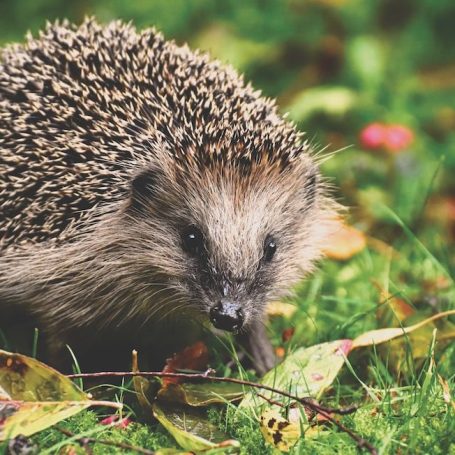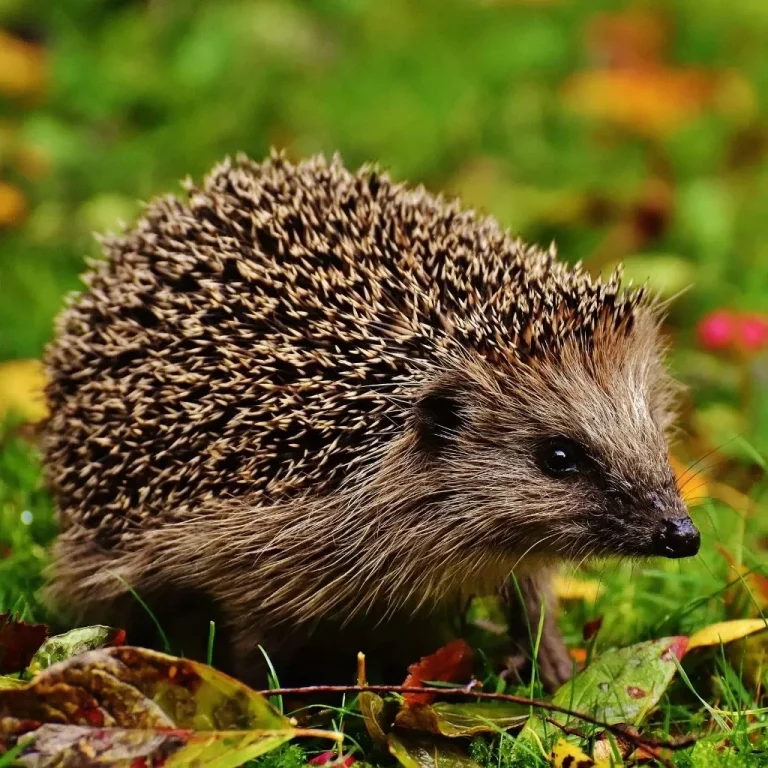Hedgehogs & Bees

Hedgehogs
When these lovely little creatures are looking for food they often make little grunting noises, and are very noisy eaters - like a pig. And they like to live in – yep you guessed it – hedges! Hence the name…Hedgehogs! They have been around over 15 million years. They are one of the oldest mammals on earth. They were around when sabre toothed tigers and Woolly mammoths were. Long before humans first evolved. 70 years ago there were thought to be 36 million hedgehogs in the UK, now that number has declined to only 1 million. This number has declined so much because of the loss and fragmentation of their habitat due to expansive building of houses and roads. We've also got rid of so many hedges (very important habit for many other species too) and replaced with low maintenance fences
Hedgehogs are nocturnal and only come out at night. They are only usually seen during the day if they are unwell or feeding for offspring. They are nocturnal because it’s safer for them and because there are fewer other animals out at night competing for the food they eat. Hedgehogs are prickly to protect themselves from other animals, Like foxes and badgers who might want to eat them for dinner. When a hedgehog is in danger it curls up into a tight ball, so all you can see are the prickles or spines. That makes them reasonably safe - although badgers are unfortunately very adept at forcing them open. In the winter when it is colder and food is more scarce hedgehogs hibernate. In the Autumn they build a special, strong warm nest called a “hibernaculum”. They curl up tight in there and stay there until spring. Only coming out once or twice maybe for a drink.
Baby hedgehogs are called hoglets, they are born in May or June. When the weather is nice and warm and there is plenty of food around to help them get big and strong. But some hedgehogs are born in September. Life is much more difficult for these hedgehogs. They will still be young when the weather gets cold. These hedgehogs born in the Autumn often need help from our hedgehog rescuers. A baby hedgehog will have 4 or 5 brothers and sisters. They stay with their Mum for just a few weeks before they are grown up enough to go off on their own. Male hedgehogs are called “boars” and females are called “sows”. They are all exactly the same as the name we give to pigs.

Some interesting facts about Hedgehogs!
They are fast!
Well faster than you'd think anyway! Hedgehogs can walk at six miles an hour. Humans walk at 3 miles an hour. So you can see, hedgehogs go pretty fast on those little legs. And they go a long way as well. Each night a hedgehog will walk more than a mile to find their food. hedgehogs are quite reasonable swimmers. And, if they have to, they can climb trees, walls and fences.
Their eyesight is rubbish!
Although they can see quite well in the dark, their eyesight is not good, so hedgehogs use their hearing and sense of smell to hunt for food.


They should not be given milk!
Lots of people leave milk out for hedgehogs...they are actually intolerant to lactose, the sugar in milk! They cannot digest it properly. they are best eating meat based cat food (not fish) or cat biscuits and drinking water.
They are super spiky!
Hedgehogs have between 5000 to 7000 spikes on their body! These are to protect them from predators...no one wants to eat something spiky! their stomach is the most vulnerable part which is why they curl into a ball when they are scared.

We can help them
The best thing we can do is make sure that our gardens are accessible and hedgehog friendly. Have a part of your garden with lawn that is not over manicured and left to grow. A hedge is the perfect garden habitat, allowing easy access between gardens, and room for piles of leaves to accumulate beneath, where hedgehogs can forage, hibernate and raise their young. Native plants, such as hawthorn and hazel, will attract egg-laying moths, increasing your stock of caterpillars - a favoured food of hedgehogs. A pile of leaves, logs or twigs or a compost heap left in a quiet corner of the garden makes the perfect hedgehog habitat, providing a warm, dry and secluded place for them to nest in and hibernate. Plus, small invertebrates, such as slugs, centipedes and beetles, will also take shelter here, providing food for hungry hedgehogs. Make a small access hole in fence panels to allow hedgehogs access to your garden. Make sure ponds don't have steep sides they need sloping sides so hedgehogs can exit easily
Be careful when gardening...check your long grass before using your strimmer. If you find any hedgehogs, move them from danger to a safe, secluded spot. Don't kill slugs! Not only could slug pellets kill hedgehogs, slugs are a food source for hedgehogs.
Hedgehogs usually hibernate between November through to mid March, but they can sometimes be seen out and about during this period changing nesting sites. It is unusual to see a hedgehog staggering around during winter or in daylight, so if you do see one and it looks unwell, it might need a helping hand.
If you think a hedgehog needs help then contact you local hedgehog rescue (see the website Yorkshire hedgehogs www.yorkshirehedgehogs.co.uk or The British Hedgehog preservation society for expert advice on what to do next
Why not buy a 'Hedgehog House' for your garden?! Hedgehogs need a dry, safe place to raise young and hibernate, and a hedgehog house is the perfect habitat. Ideally, cover it with plastic sheeting and a layer of leaves and make an entrance tunnel (around 12cm x 12cm and 40cm long) to prevent predators getting in. Site it under a north-facing hedge, out of the way. give them a helping hand with supplementary food, especially before and after hibernation. Offer meat-based dog or cat food, or biscuits preferably chicken or turkey flavour


Bees
For Bees food comes from the plants they visit. Plants provide bees with nectar (carbohydrate) and pollen (protein) and bees provide plants with a pollination service!
Nectar forms the basis of honey, the energy rich food that honey bees need to sustain the life of the colony while pollen provides the protein, vitamins and other nutrients needed for the developing larvae (baby bees)! Storing food i.e. honey, allows honey bees to survive in times of scarcity and across a wide range of habitats and climatic conditions, this makes the honey bee one of the earth’s most adaptable species.
While bees and other insects are visiting flowers to feed, they spread pollen from one plant to another. This enables flowers to be fertilised and for seeds and fruit to form. This makes bees and other pollinators the sex organs of plants!
Humans benefit greatly from the natural relationship between bees and plants. Insect pollination is the mechanism that allows us to harvest crops and seeds throughout the world and people harvest surplus honey stored by bees.
Worldwide, about 40,000 plant species are of value to bees while about 4,000 are the source of most of the worlds’ honey. Beekeepers who have acquired a good knowledge of the floral sources in their locality will be able to maintain their colonies in the best places for getting honey. Part of the skill of beekeeping is to enable the maximum population of foraging bees at the time when there is the maximum number of flowers.
Forests and trees offer vital habitat and food for honey bees, especially in tropical regions. Beekeepers can protect their honey harvest by protecting the habitat - trees and plants that give the bees both food and shelter. Other wildlife is also sustained, maintaining the world’s biodiversity while we get to enjoy the beauty of the flowers that plants use to attract pollinators.

Some interesting facts about bees!
Smelly Feet
Scientists from the University of Bristol have discovered that bumblebees have the ability to use their ‘smelly footprints’ to distinguish between their own scent, the scent of a relative and the scent of a stranger. This means they can improve their success in finding food and avoid flowers that already have been visited.
They can dance
Honeybees have a dance move called the ‘waggle dance’. It’s not actually a dance move at all, rather a clever way of communicating between themselves to tell their nestmates where to go to find the best source of food. It took the researchers at Sussex University two years to decode the waggle dance. They effectively tell each other what angle to fly out of the hive in relation to the sun and how far....


We Need them
Almost 90% of wild plants and 75% of leading global crops depend on insect pollination. One out of every three mouthfuls of our food depends on pollinators such as bees. Crops that depend on pollination are five times more valuable than those that do not.
They make queens
If the queen bee dies in a honeybee hive the workers can create a new queen bee. They do this by selecting a young larva and by feeding it special food called ‘royal jelly’ that they secrete from their mandibles. The larva will develop into a fertile queen with fully developed ovaries. The worker bees ovaries are only semi-developed

We can help them
If you find a bumblebee which appears to be struggling, it may be that it is just tired and resting, particularly if the bee is a queen in early spring. If you think the bee is struggling the best thing to do is gently put the bee onto a bee-friendly flower. If there are no bee-friendly flowers around, mix 50/50 white sugar and water to give the bumblebee as a one-off energy boost, providing the carbohydrates it needs to fly. Simply offer a drop or two of sugar water up to the front end of the bee on a teaspoon or an upturned drinks cap in a sheltered place and allow the bee time to recuperate (It is not advisable to use brown sugar as it is harder for bees to digest and can cause dysentery and don’t give bumblebees honey as this can contain pathogens)
We can all do our bit to help bees whether that’s in our gardens, balconies or windowsills. You can also chat to friends and family about how cool bees are and help them to make their wild spaces bee-friendly as the biggest threat facing bees is habitat loss. Plant a range of flowers in your garden so bees have access to nectar from March to October. Bees love simple open flowers and traditional cottage garden flowers and native wildflowers, like primrose, foxglove, and marigolds.
choose honey carefully!- try to go for something local, from individual beekeepers who practice sustainability. This way you know where your honey is coming from and can cut down on the carbon emissions used to ship honey to your local supermarket - mass produced honey is often doctored and adulterated with corn syrup or other cheap sweeteners
Buying honey from local beekeepers ensures that you are getting an untainted, artisan product
If you are near Leeds you could get your honey from Benefer’s Bees!

© Copyright. All rights reserved.